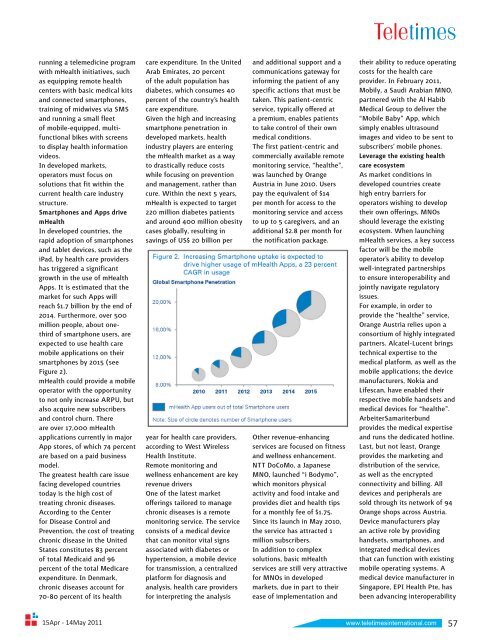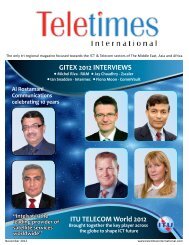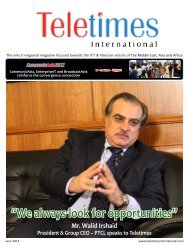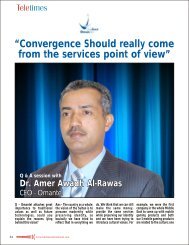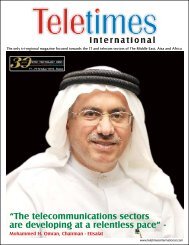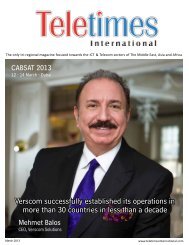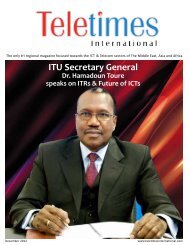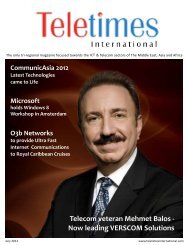Teletimes April 2011.pdf
Teletimes April 2011.pdf
Teletimes April 2011.pdf
You also want an ePaper? Increase the reach of your titles
YUMPU automatically turns print PDFs into web optimized ePapers that Google loves.
unning a telemedicine program<br />
with mHealth initiatives, such<br />
as equipping remote health<br />
centers with basic medical kits<br />
and connected smartphones,<br />
training of midwives via SMS<br />
and running a small fleet<br />
of mobile-equipped, multifunctional<br />
bikes with screens<br />
to display health information<br />
videos.<br />
In developed markets,<br />
operators must focus on<br />
solutions that fit within the<br />
current health care industry<br />
structure.<br />
Smartphones and Apps drive<br />
mHealth<br />
In developed countries, the<br />
rapid adoption of smartphones<br />
and tablet devices, such as the<br />
iPad, by health care providers<br />
has triggered a significant<br />
growth in the use of mHealth<br />
Apps. It is estimated that the<br />
market for such Apps will<br />
reach $1.7 billion by the end of<br />
2014. Furthermore, over 500<br />
million people, about onethird<br />
of smartphone users, are<br />
expected to use health care<br />
mobile applications on their<br />
smartphones by 2015 (see<br />
Figure 2).<br />
mHealth could provide a mobile<br />
operator with the opportunity<br />
to not only increase ARPU, but<br />
also acquire new subscribers<br />
and control churn. There<br />
are over 17,000 mHealth<br />
applications currently in major<br />
App stores, of which 74 percent<br />
are based on a paid business<br />
model.<br />
The greatest health care issue<br />
facing developed countries<br />
today is the high cost of<br />
treating chronic diseases.<br />
According to the Center<br />
for Disease Control and<br />
Prevention, the cost of treating<br />
chronic disease in the United<br />
States constitutes 83 percent<br />
of total Medicaid and 96<br />
percent of the total Medicare<br />
expenditure. In Denmark,<br />
chronic diseases account for<br />
70-80 percent of its health<br />
care expenditure. In the United<br />
Arab Emirates, 20 percent<br />
of the adult population has<br />
diabetes, which consumes 40<br />
percent of the country’s health<br />
care expenditure.<br />
Given the high and increasing<br />
smartphone penetration in<br />
developed markets, health<br />
industry players are entering<br />
the mHealth market as a way<br />
to drastically reduce costs<br />
while focusing on prevention<br />
and management, rather than<br />
cure. Within the next 5 years,<br />
mHealth is expected to target<br />
220 million diabetes patients<br />
and around 400 million obesity<br />
cases globally, resulting in<br />
savings of US$ 20 billion per<br />
year for health care providers,<br />
according to West Wireless<br />
Health Institute.<br />
Remote monitoring and<br />
wellness enhancement are key<br />
revenue drivers<br />
One of the latest market<br />
offerings tailored to manage<br />
chronic diseases is a remote<br />
monitoring service. The service<br />
consists of a medical device<br />
that can monitor vital signs<br />
associated with diabetes or<br />
hypertension, a mobile device<br />
for transmission, a centralized<br />
platform for diagnosis and<br />
analysis, health care providers<br />
for interpreting the analysis<br />
and additional support and a<br />
communications gateway for<br />
informing the patient of any<br />
specific actions that must be<br />
taken. This patient-centric<br />
service, typically offered at<br />
a premium, enables patients<br />
to take control of their own<br />
medical conditions.<br />
The first patient-centric and<br />
commercially available remote<br />
monitoring service, “healthe”,<br />
was launched by Orange<br />
Austria in June 2010. Users<br />
pay the equivalent of $14<br />
per month for access to the<br />
monitoring service and access<br />
to up to 5 caregivers, and an<br />
additional $2.8 per month for<br />
the notification package.<br />
Other revenue-enhancing<br />
services are focused on fitness<br />
and wellness enhancement.<br />
NTT DoCoMo, a Japanese<br />
MNO, launched “i Bodymo”,<br />
which monitors physical<br />
activity and food intake and<br />
provides diet and health tips<br />
for a monthly fee of $1.75.<br />
Since its launch in May 2010,<br />
the service has attracted 1<br />
million subscribers.<br />
In addition to complex<br />
solutions, basic mHealth<br />
services are still very attractive<br />
for MNOs in developed<br />
markets, due in part to their<br />
ease of implementation and<br />
their ability to reduce operating<br />
costs for the health care<br />
provider. In February 2011,<br />
Mobily, a Saudi Arabian MNO,<br />
partnered with the Al Habib<br />
Medical Group to deliver the<br />
“Mobile Baby” App, which<br />
simply enables ultrasound<br />
images and video to be sent to<br />
subscribers’ mobile phones.<br />
Leverage the existing health<br />
care ecosystem<br />
As market conditions in<br />
developed countries create<br />
high entry barriers for<br />
operators wishing to develop<br />
their own offerings, MNOs<br />
should leverage the existing<br />
ecosystem. When launching<br />
mHealth services, a key success<br />
factor will be the mobile<br />
operator’s ability to develop<br />
well-integrated partnerships<br />
to ensure interoperability and<br />
jointly navigate regulatory<br />
issues.<br />
For example, in order to<br />
provide the “healthe” service,<br />
Orange Austria relies upon a<br />
consortium of highly integrated<br />
partners. Alcatel-Lucent brings<br />
technical expertise to the<br />
medical platform, as well as the<br />
mobile applications; the device<br />
manufacturers, Nokia and<br />
Lifescan, have enabled their<br />
respective mobile handsets and<br />
medical devices for “healthe”.<br />
ArbeiterSamariterbund<br />
provides the medical expertise<br />
and runs the dedicated hotline.<br />
Last, but not least, Orange<br />
provides the marketing and<br />
distribution of the service,<br />
as well as the encrypted<br />
connectivity and billing. All<br />
devices and peripherals are<br />
sold through its network of 94<br />
Orange shops across Austria.<br />
Device manufacturers play<br />
an active role by providing<br />
handsets, smartphones, and<br />
integrated medical devices<br />
that can function with existing<br />
mobile operating systems. A<br />
medical device manufacturer in<br />
Singapore, EPI Health Pte, has<br />
been advancing interoperability<br />
15Apr - 14May 2011<br />
www.teletimesinternational.com<br />
57


